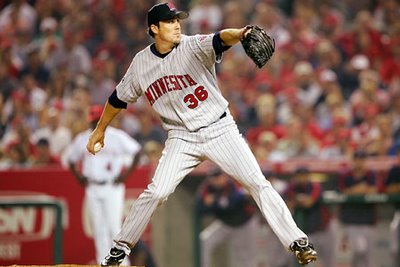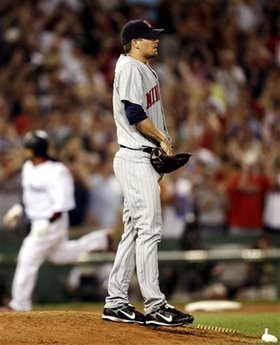July 8, 2008
Two Losses, No Nathan
Tied at 0-0 in the eighth inning on the road is an incredibly crucial, game-changing situation and using Nathan there makes more sense than holding him back for a "save situation" that a) may never arrive, and b) has more margin for error even if it does materialize. If not for the fact that the accumulation of a statistic has somehow defined bullpen usage, would anyone think that closing out a lead of 1-3 runs in the ninth inning is more important than coming into a 0-0 game in the eighth inning? They shouldn't.
 Instead of using the team's best reliever in a spot that couldn't get much more important Monday night, Gardenhire called on the team's worst reliever. And not only is Bass the Twins' worst reliever, he's been used all season in a mop-up role reserved for such a player and because of that has rarely been asked to pitch in spots anywhere near as important as the eighth inning of a 0-0 game at Fenway Park. Here's a look at the bullpen's Leverage Index averages:
Instead of using the team's best reliever in a spot that couldn't get much more important Monday night, Gardenhire called on the team's worst reliever. And not only is Bass the Twins' worst reliever, he's been used all season in a mop-up role reserved for such a player and because of that has rarely been asked to pitch in spots anywhere near as important as the eighth inning of a 0-0 game at Fenway Park. Here's a look at the bullpen's Leverage Index averages:
LI
Joe Nathan 1.87
Pat Neshek 1.54
Dennys Reyes 1.36
Matt Guerrier 1.23
Jesse Crain 1.13
Juan Rincon 0.75
Bobby Korecky 0.56
Brian Bass 0.52
Craig Breslow 0.48
Boof Bonser 0.33
If you're unfamiliar with Leverage Index, the short version is that the higher a reliever's number gets the more crucial his appearances have been. Nathan has the highest LI on the Twins (and sixth-highest in the AL) because he typically either pitches with a small lead or doesn't pitch at all. Before his injury Pat Neshek ranked second in LI because while Nathan was being held back for save chances, Gardenhire was able to plug him into key spots without worrying about the accumulation of a statistic.
Bass is at the opposite end of the spectrum. His LI ranks behind Nathan, Neshek, Dennys Reyes, Matt Guerrier, Jesse Crain, Juan Rincon, and Bobby Korecky. Only Craig Breslow (who's been used as a second left-hander since being claimed off waivers mid-year) and Boof Bonser (who's in the bullpen thanks to being demoted from the rotation) have worked in lower-leverage spots than Bass. In fact, as of Monday no reliever in the entire league with at least 30 innings had a lower LI than Bass. Seriously.
Bass is the worst pitcher in the bullpen and has appeared almost exclusively in mop-up situations this season, to the point that his LI was the lowest in the entire league. Yet there he was, facing the heart of the Red Sox's lineup--Dustin Pedroia, J.D. Drew, Manny Ramirez, Mike Lowell--in the eighth inning of a 0-0 game on the road. Crain was brought into the game after Bass coughed up what proved to be the game-winning run and Nathan never even took the mound in a 1-0 loss.
Facing the Red Sox again last night, the Twins held leads of 4-2 in the seventh inning and 5-2 in the eighth inning. Gardenhire brought in Reyes and then Guerrier, which was to be expected given that they rank second and third behind Nathan for the highest LI on the team if you set Neshek aside due to his season-ending injury. LI shows that Reyes and Guerrier are the setup men Gardenhire calls upon to pitch in the tightest spots, and rightfully so given that they've been the best non-Nathan relievers.
Unfortunately, Reyes served up a double to Jacoby Ellsbury leading off the eighth inning and Guerrier allowed that run and three others to score after relieving him, as the Red Sox took a 6-5 lead that held up for the victory. Two games in two nights lost in the eighth inning. One by Bass. One by Reyes and Guerrier. And both while the team's best, highest-paid reliever watched from the bullpen, unused, while being held back for a "save situation" that never arrived.
 Nathan hasn't thrown 20 pitches in an outing since May 22 and has done so a total of seven times all season. By comparison, Guerrier has thrown 20-plus pitches 16 times, including last night, and Crain has done so 12 times despite coming off shoulder surgery. Guerrier has thrown 30 or more pitches eight times, whereas Nathan has yet to go past 26 pitches. Nathan is on pace to log a career-low 66 innings, while Bass and Guerrier are on pace for 99 and 79 innings, respectively.
Nathan hasn't thrown 20 pitches in an outing since May 22 and has done so a total of seven times all season. By comparison, Guerrier has thrown 20-plus pitches 16 times, including last night, and Crain has done so 12 times despite coming off shoulder surgery. Guerrier has thrown 30 or more pitches eight times, whereas Nathan has yet to go past 26 pitches. Nathan is on pace to log a career-low 66 innings, while Bass and Guerrier are on pace for 99 and 79 innings, respectively.
As usual Nathan has been amazing, posting a 1.23 ERA while converting 25-of-27 save chances, but he's appeared in just 10 of the team's 53 games when a save chance wasn't available. Why is his workload so minimal? Why are second- and third-tier relievers regularly given opportunities to lose games in the late innings while he goes unused? Because Gardenhire, like most managers, let's the "save" determine his bullpen usage instead of simply using his best reliever in the most crucial spots.
It wasn't so long ago that the best relievers in baseball regularly logged 100 or even 120 innings per year, but now elite relievers like Nathan rarely pitch even 75 innings. As the Twins have seen over the past two nights, those "extra" innings trickle down to the bullpen's lesser options and can lead to tough losses occurring without the best reliever on the team even seeing any action. That's the way modern bullpens are deployed, so the Twins aren't alone, but that doesn't make it any less of a mistake.
Expecting Gardenhire to give Nathan the same type of workload that elite relievers had in the 1950s, 1960s, 1970s, and early 1980s is beyond wishful thinking given that only a handful of managers in all of baseball have tried that over the past decade. Plus, allowing Nathan to throw 100 or 120 innings per season would probably be a mistake anyway. However, there's nothing to suggest that he's incapable of perhaps occasionally throwing 25 pitches or maybe entering a key game in a non-save situation.
When a game is tied at 0-0 in the late innings, why wouldn't the team's best reliever be the first one out of the bullpen? When a three-run lead is slipping away in the eighth inning, why wouldn't the team's closer be brought in to put out the fire? When a great setup man goes down with a season-ending injury, why wouldn't the overpowering bullpen stud with a 1.86 ERA in five seasons with the team be allowed to throw more than three innings per week? Nathan is an extraordinary reliever. Use him.
Once you're done here, check out my latest "Daily Dose" column over at Rotoworld.

